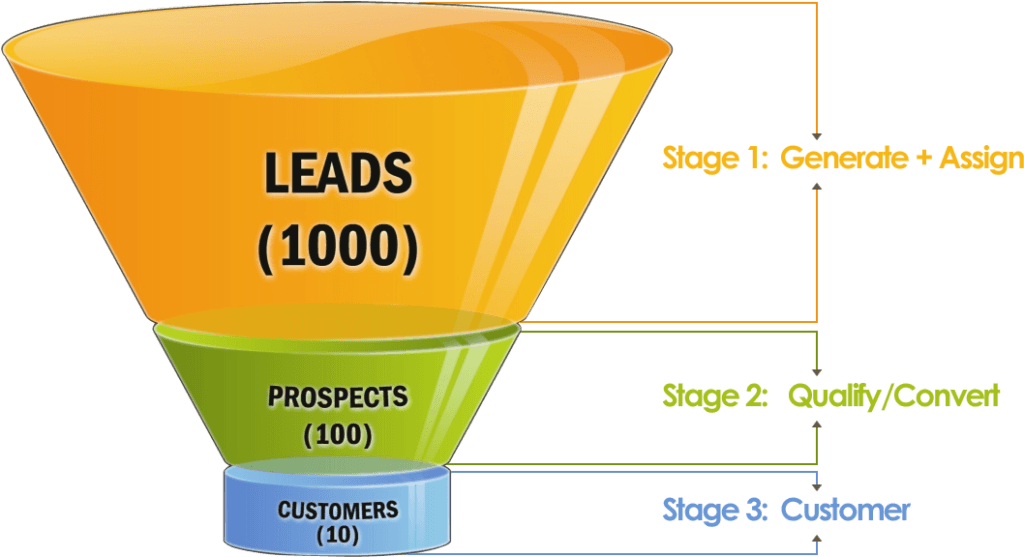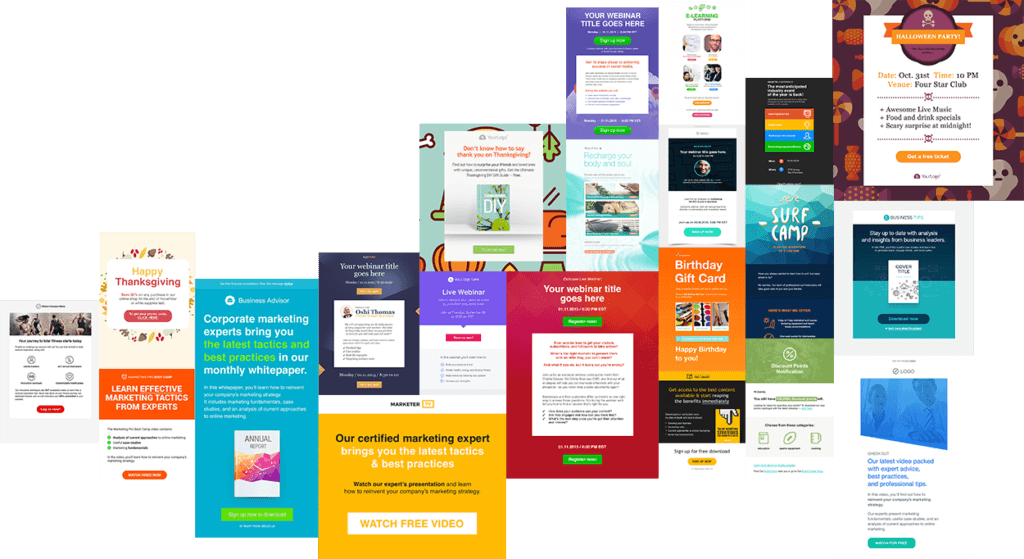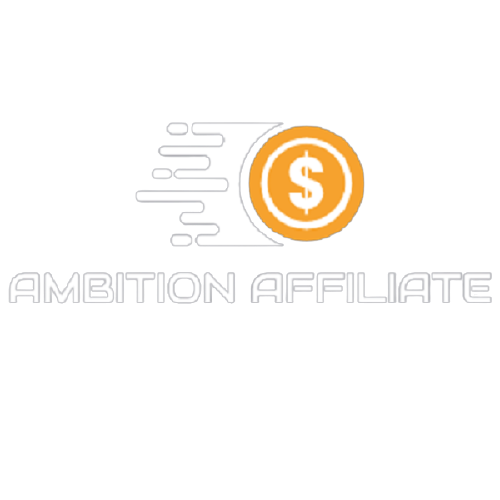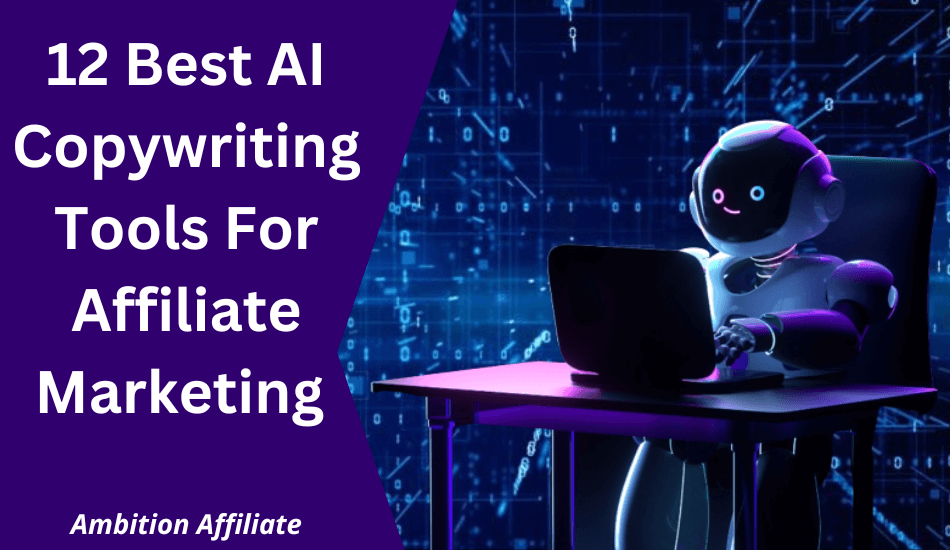Without an effective lead generation funnel, it’s nearly impossible to generate high-quality sales leads and convert them into sales. It’s an integral part of your digital marketing strategy and your most important chance to find and reach your ideal customers.
Your lead generation funnel should help move prospects from attention to action. So if done correctly, lead generation is a process that can produce exceptional results in a short period of time.
“Sales Funnels”, “Lead Funnels”, “Conversion Funnels”, “Marketing Funnels” … usually these all refer to the same thing, more or less. For many marketers, there is arguably still a difference between these terms. But in the end, it all boils down to a similar concept: a funnel. A funnel is based on the framework in which consumers go through various stages before purchasing a product or service.
A clear understanding of the process and stages behind a lead generation funnel is critical to optimizing campaigns and ensuring that you, the paying customer, get from the top of the funnel down.
It’s also important to note that a lead generation funnel is applicable to both online and offline businesses. And your funnel can be spread across multiple channels so you can best target the audience you want on any relevant platform.
Table of Contents
What is a lead generation funnel?
Think of the concept of a lead generation funnel as a kitchen funnel in the truest sense of the word. If you factor in the size of your initial target audience and then compare that to the size of customers who have reached the point of sale, the volume looks pretty much the shape of a funnel.
 In the first stage, the widest part of the funnel above, you want to qualify and interact with as many people as possible who are in your ideal audience. While a lot of people will see your ad, not all of them will take action if they continue clicking. Hence, the next level already has some of those original audiences that have already bailed out.
In the first stage, the widest part of the funnel above, you want to qualify and interact with as many people as possible who are in your ideal audience. While a lot of people will see your ad, not all of them will take action if they continue clicking. Hence, the next level already has some of those original audiences that have already bailed out.
These visitors, in turn, may or may not take further action after arriving on your landing page. Some can cancel at this point and go back to what they did while others download the giveaway on your sign-up form. Those who have signed up will be automatically registered in your database and will receive an automated email sequence that you have set up in your email autoresponder.
Of course, some subscribers will break off by unsubscribing from your communications – but others will ultimately buy your offer. The sales funnel getting narrower as visitors move through it. This is partly because you have more potential customers at the top of the funnel than buyers at the bottom, but also because your messages need to become increasingly targeted.
When it comes to the first audience you reach, most of the funnel, you want to make sure you don’t actually reach everyone. The reason for this is that getting bad traffic is a waste of resources. You just don’t need it.
Targeted traffic, are visitors who are likely to be interested in buying your listing. These are the people you want targeted messages to reach, and more than possible.
Example of a lead generation funnel
Let me use an example to illustrate a basic funnel concept. Let’s say you run a local bakery that offers a package for an engagement party.
At the top of your marketing funnel, you want to focus on getting targeted traffic to your landing page. There are a few different ways you can do this, but let’s say you’re using paid ads and running a social media advertising campaign to reach your ideal audience.
After visitors click your ad, you want them to become prospects. You can offer them a free download for a guide on the biggest mistakes when choosing frosting for a party cake and how to avoid them. In exchange for your email, send it to your inbox for free. Part of the original audience breaks off at this point because they don’t feel compelled to take any further action.
Those who have taken action will immediately receive the download along with a well-designed welcome email. It will be the first of many in an automated email sequence sending two emails a week with various tips for planning a party. Every email relates to this customer avatar, his weak points, and his needs.
You have now successfully pushed them further into the center of your funnel. Yes, some will unsubscribe or start ignoring your email at this point. It’s not personal so go ahead!
As you read your weekly emails and receive valuable party planning tips, your subscribers will begin to trust your brand and recognize you as an authority on the field.
Some may realize that making memorable and delicious pastries is not as easy as they imagined it to be, and they are beginning to understand why they should rather entrust experts to do the job for their intended celebration in the best possible way.
And this is exactly where your offer starts from your email back to a sales landing page.
This really is your time to shine. Do some research, optimize your landing page, and test everything A / B. Your customers need to feel that your baked goods and cakes enrich their celebrations and that everything is handled carefully so that they can relax and have one less task on their plate.
Prospects can purchase your package either directly through your landing page or any other purchase method you prefer.
It is worth noting that you must not forget to re-address those who did not complete a purchase, abandoned the cart, and withdrew. You can be revived! In fact, there should be a strong strategy in place at every stage of your marketing funnel to catch all of those who break off at each stage.
When something breaks, you need to get the bigger picture to anticipate a bottleneck or rift where you will lose potential customers.
How to Build a Lead Generation Funnel
Create a landing page with a high conversion rate
 A landing page is the first impression potential customers have of your brand, and it’s a critical element in the success of any lead generation strategy. Here you have the opportunity to capture leads by collecting their contact information, usually an email address.
A landing page is the first impression potential customers have of your brand, and it’s a critical element in the success of any lead generation strategy. Here you have the opportunity to capture leads by collecting their contact information, usually an email address.
Of course, you want to make sure that it’s not just a good landing page, but a great one. If a potential customer lands on your website and it doesn’t live up to their expectations, you are likely to lose a lot of potential buyers at the top of the funnel.
This in turn increases your bounce rate as well. In web traffic data, bounce rate is the percentage of visitors who leave a web page without taking action before leaving. A high bounce rate affects your SEO as it is a sign to search engines like Google that the content is either poor quality or irrelevant to the search query.
Directing prospects to attractive and well-designed websites can help you reach your target audience and make sure they have a reason to come back.
So it’s worth taking the time to create a seamless web experience and continually tweaking your landing page to maximize your conversion rate. Start by outlining a simple and clear message that will grab attention, showcase the value proposition, and get leads to take action.
A page and funnel builders like GroovePagesⓇ (free) or ClickFunnels ($ 1,164 + p / y) allow users to create landing pages with pre-made templates that are best optimized for conversions in the top half of your funnel – without any coding or technical knowledge.
You can sign up with a free Groove.CM account
and replace all of your online business tools and for a limited time, GroovePagesⓇ offers free lifetime access:
• Create up to three funnels or websites
• Free page and site hosting
• Starter pack for premium content blocks
• Wireframe blocks
• A funnel templates
• Three custom domains
Here are some more tips for creating a landing page that converts:
• Issue a call for action
Your text and visual media are designed to attract visitors and lower bounce rates, but that doesn’t automatically lead to conversions unless you ask visitors to take some kind of action. A “call-to-action” (CTA) is a marketing term for any design and use of phrases that trigger an immediate response from potential customers.
Ultimately, a CTA is a primary goal of creating a landing page. The best practice is that a CTA is: Persuasive, identifiable, clear and understandable, and strategically placed on your website. In most cases, CTAs will be a brightly colored, large-format button that says, “Register Here”.
• Provide an incentive to take action
As mentioned earlier, the CTA is the ultimate goal of your landing page. So everything on your landing page should be about meeting the CTA – and that includes something in return. This can take the form of coupons, free ebooks, exclusive content, or other popular lead magnets. If a prospect feels that their action is adequately rewarded, they are more likely to convert.
The incentive itself should also have a purpose. In other words, it has to be relevant to your funnel and lead generation offers. The goal is to generate more conversions at the bottom of the funnel.
Bring people to your landing page
Even the best landing page in the world wouldn’t matter if you couldn’t get someone to look at it. So you need to market your marketing page! Traffic generation is a broad topic as there are many ways to drive prospects to your landing page. The best option for your lead generation funnel depends on your business and budget.
In general, you can use:
• Paid ads (Facebook and Google). This is not the cheapest option but is considered to be one of the most effective means in terms of advertising spend.
• Email Marketing. This is a good option, but only applicable if you have an established, well-kept email list.
• Social media. Make the most of your social media accounts by posting regularly and going live to reach your audience.
• Content Marketing. SEO is the best strategy for organic reach, so it’s important to optimize your landing page or have blog posts.
Collect email addresses
Next, you want to use your lead generation funnel to collect the email addresses of the visitors who click on your landing page from the respective traffic source. If you’ve followed the advice in Step 1, you already have a great landing page that makes it as easy as possible for people to volunteer their email addresses.
Remember that your landing page opt-in form needs to be optimized for mobile devices and easy to navigate on any device. Once you’ve captured a lead’s email address, it’s time to start an automated drip campaign.
Set up a drip campaign
 A drip campaign is a slow but steady campaign of emails sent to prospects who have given you their email address and have chosen to receive further communications from you. The idea is to build trust and develop a relationship until the prospect is ready to make a purchase.
A drip campaign is a slow but steady campaign of emails sent to prospects who have given you their email address and have chosen to receive further communications from you. The idea is to build trust and develop a relationship until the prospect is ready to make a purchase.
Here is an example of a typical drip campaign:
Email 1: Welcome. Thank the prospect for their interest in your product or service and, if necessary, provide the lead magnet.
Email 2: Giveaway. Send the prospect another high-quality giveaway that contains information relevant to their initial expressed interest.
Email 3: Story. Include your personal story that will help prospects resonate with your brand.
Email 4: Testimonials. Add a customer testimonial about your product or service.
Email 5: Close. Go to the “hard close” with convincing texts that convince and convert.
Conclusion
If you know what a lead generation funnel is and knowing your marketing funnel inside and out, you can invest in the right marketing activities and channels, creating the most relevant messages at each stage and converting more prospects into paying customers.
To Your Success.




